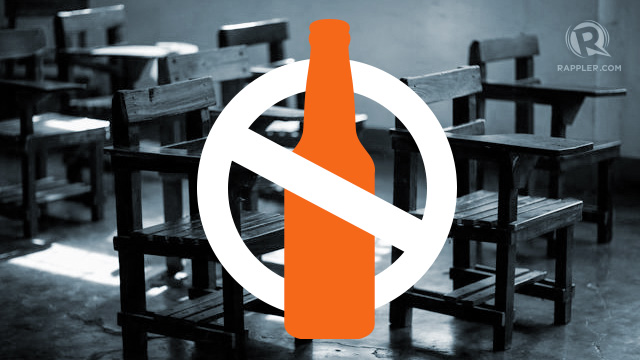SUMMARY
This is AI generated summarization, which may have errors. For context, always refer to the full article.

There’s always danger in wanting to control other people’s behavior in the belief that it’s for their own good.
Take the case of soft drinks, which many regard as unhealthy. Coaxing a friend into drinking something else, perhaps out of concern, is one thing. But imposing an outright ban across the country (and using the state’s machinery to punish violators) is a wholly different ball game.
This is exactly what’s being proposed by Representatives Kaka Bag-ao and Leni Robredo when they recently filed the “Healthy Beverage Options Act of 2014” in Congress. The bill seeks to ban the sale of beverages deemed “unfit” for children in public and private schools, from kindergarten to high school. (READ: Bill seeks to ban soft drinks in schools)
But the proposed ban covers not just soft drinks, but also sports drinks, punches, iced tea, caffeinated drinks, except low-fat chocolate milk, and fruit-based drinks with less than 50% real fruit juice and those containing additional sweeteners.
Will this soda ban work once it’s passed? Will school children ditch soft drinks overnight just because a law tells them to do so?
If the past is any indication, the answer is and must be a resounding “no.” Simply because legislated bans throughout history almost always never work, and have, in fact, resulted in outcomes that are worse than what their proponents had originally intended.
The Prohibition
The most glaring example of this was the Prohibition in the United States from 1920 to 1933.
The Prohibition’s intention was simple and well meaning. By the 18th century, excessive alcohol consumption was said to have caused a “breakdown” in American morals and decency.
Borne out of this concern, the Prohibition – which took the form of no less than a constitutional amendment – banned the “manufacture, sale, or transportation of intoxicating liquors,” primarily beer.
Initially, the Prohibition resulted in a drastic reduction in alcohol consumption that led many to believe it was a success. However, such early gains were short-lived and by 1930 the Prohibition was repealed. Even its most vocal proponents were forced to admit its failure, saying it had spawned “an orgy of lawlessness and official corruption.”
What gives?
For starters, the things the Prohibition didn’t ban turned out to be as crucial as what it did ban. Soon people started turning to substitute goods, and the consumption of even more dangerous products – such as tobacco, marijuana, and narcotics – rose.
Second, the Prohibition never successfully eliminated the demand for liquor, and this spawned the creation of black markets shrouded with corruption. The profit motive was so great that those who had legal access to liquor (such as physicians and ministers) could be easily bribed to let go of their stocks.
Third, so many had violated the ban that ultimately the Prohibition proved to be simply unenforceable. Organized crime, including a syndicate led by the infamous Al Capone, took over the trafficking of illegal liquor. And these criminal groups were always one step ahead of the authorities trying to catch them, and who were too few to begin with.
As this episode in history demonstrates, people go to great lengths to circumvent bans on things they love to consume.

Loopholes
Today, with the rise of obesity worldwide especially among the youth, soft drinks have proven to be the new alcohol. At least 30 countries worldwide are currently implementing some form of government restriction on the availability of soft drinks, especially in schools where youth are prone to consuming them.
Here in the Philippines, imposing similar restrictions are nothing new. But while some schools have managed to implement their bans, others have not met with similar successes.
Indeed, there are many levels on which a nationwide ban on soft drinks in schools could fail.
First, discouraging the consumption of soft drinks won’t prevent children from consuming its substitute goods.
For instance, one recent study in the US found that discouraging soft drink consumption among children and adolescents led to an increase of consumption of whole milk. Since any reduction in calories from drinking soft drinks was completely offset by an increase in calories from drinking whole milk, the soda restriction was found to be virtually useless where the obesity issue was concerned.
So shouldn’t we also ban all the other unhealthy goods that kids might turn to during recess? Where do we draw the line between state regulation and freedom of commerce?
Second, banning soft drinks within school grounds won’t prevent young people from buying and consuming soft drinks outside of school. After all, kids and adolescents could still consume soft drinks at home, in fastfood restaurants, or even just a few meters outside of school grounds.
If anything, a school ban might nudge kids to cross the street just so they could buy their sodas, needlessly exposing themselves to traffic hazards.
Third, the farther away sodas are banned outside of schools, the higher the chances that black markets will arise from within school walls, with no less than school staff being involved in the illegal trade. Besides, a nationwide ban will be virtually impossible to monitor 100% of the time, and, where no one is looking, some may see the profit motive too powerful to resist.
Sodas vs calories
If public health is the ultimate concern, then a policy on soda consumption should be clear on its goals: Is soda consumption the real enemy, or the excess calories in children’s diets?
Because even with a soda ban in place, it’s very likely that kids and adolescents (with or without the aid of adults around them) will still consume “unhealthy” calories anyway – if not from sodas, then from its substitute drinks or its complements like chips and other junk food.
Of course, this isn’t to say that no causal relation exists between soft drink consumption and poor health outcomes in children. But history tells us that if we want to influence or control how people consume products they like, the worst thing that can be done is to ban them altogether.
People, if they could help it, prefer freedom over coercion. And just like people’s response to the Prohibition, school children won’t part with their sodas so easily just because a law tells them to do so.
Not a school project
The soda ban bill filed in Congress was partly inspired by the efforts of Chip “Soda Slayer” Gatmaytan, a 10-year-old whose school project to promote children’s health has turned into a full-blown advocacy.
Chip is certainly too young to have studied the Prohibition in school, much less the law of unintended consequences. Until he does, I hope that children like him are not used as poster boys in legislative proposals that, although well meaning, ignore the lessons of history and poorly understand certain regularities in the nature of human behavior.
Instead, it would be much better to teach kids that people are not robots who blindly follow orders, and that meddling with human behavior (especially where the state’s coercive powers is involved) can be a complex and unpredictable affair.
Thus, seeking to regulate other people’s behavior should never be taken as lightly as, say, presenting a school project at the science fair. – Rappler.com
JC Punongbayan holds a master’s degree from the UP School of Economics, where he also graduated summa cum laude in 2009 and currently teaches part-time. His views are independent of the views of his affiliations.
Add a comment
How does this make you feel?
There are no comments yet. Add your comment to start the conversation.